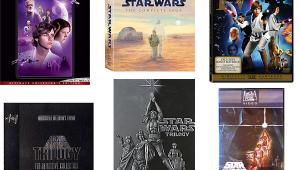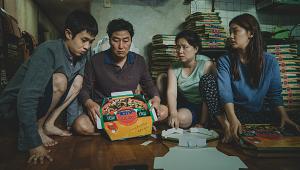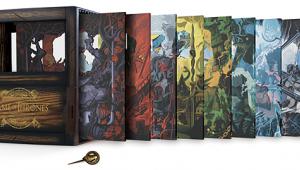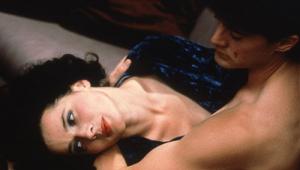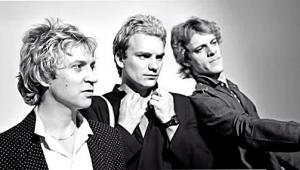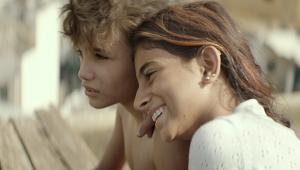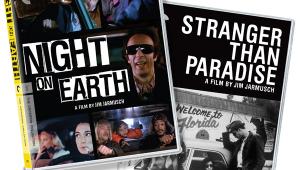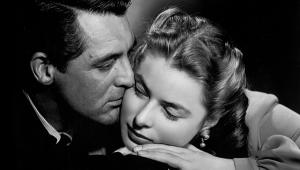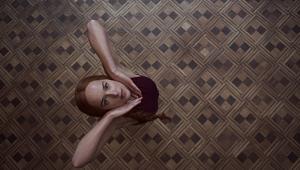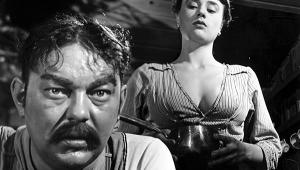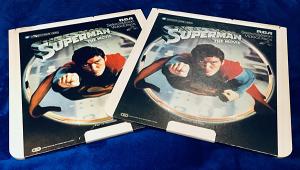Bambi
Picture ****
Sound ***
Film ***
The restoration of a classic.
Perhaps no Disney classic animation feature has been more highly awaited on DVD than Bambi. The product of an earlier time, when animated features were unabashedly sentimental, it is perhaps the most gentle, innocent, and sentimental of the lot.
 But the times were neither gentle nor sentimental when the film was first released. The United States had just entered World War II, and most overseas markets were closed to Disney and other Hollywood studios. Despite the fact that Bambi was reportedly Walt's favorite animated feature, it didn't break even until its re-release in the 1950s.
But the times were neither gentle nor sentimental when the film was first released. The United States had just entered World War II, and most overseas markets were closed to Disney and other Hollywood studios. Despite the fact that Bambi was reportedly Walt's favorite animated feature, it didn't break even until its re-release in the 1950s.
Most films of that era have deteriorated badly. Earlier (non-DVD) video releases of the film suffered from age- and wear-related flaws. Something had to be done to return the movie to its original glory before a first-class DVD presentation would be possible. And a good DVD might even look and sound better than the original. That isn't a heretical suggestion; today's best video technology can get far more out of a film than the audio and projection systems available in 1942. While many would love to see even a limited theatrical release of the restored version, for the time being this outstanding video release will do nicely—at least when viewed on the biggest screen possible.
The Restoration The original camera negative was stored in an underground vault at the Library of Congress. Despite routine maintenance, many early films stored there, and elsewhere, are literally disappearing. Bambi, like many films of that time, was photographed on nitrate film stock. Apart from being highly flammable, nitrate gradually dissolves into dust. That's one reason most of the films produced in the silent era, not to mention some later ones, are now gone forever.
Fortunately, Bambi's negative was in good shape. The movie had also been shot in Technicolor, which involves three separate black-and-white negatives, one each for the red, green, and blue elements of the image. The final color release prints were then made by combining these elements in what is known as a dye-transfer process. Since the negatives themselves are not color, they can't fade over time.
Once back at the Disney studios, each frame of these original negatives was inspected and scanned at a resolution of 4000x3000 (!). The black-and-white files were then combined to create each final color frame. Dust, dirt, and scratches were removed through computer processing. The work took four months.
Inevitably, there are problems in color matching any such restoration with the original. The original prints change slightly over time, so comparing them to the computer restoration of the negatives might not accurately convey what the artists saw in the early '40s. And to be honest, the prints made in the 1940s using what was a still very young color process probably differed from what the artists created on their drawing boards! The Disney restoration team screened an original Technicolor dye-transfer 1950s-era theatrical print to check the color. But to be as true to the original as possible, they also retrieved the original hand-painted backgrounds from the Disney animation vaults (yes, they kept everything!) to use as a final reference.
The restorers also went into the sound archives and retrieved the original mono master, the music and effects master, and the vocal and music-effects master for the restoration. These were sent to Andreas Meyer at Sony Classics New York, where audio artifacts from the era's limited sound technology were minimized.
Back at Disney, these cleaned-up elements were used to create an enhanced 5.1 mix, dubbed Disney Enhanced Home Theater (DEHT). While similar in theory to the first DEHT mix produced for the DVD release of The Lion King, the fact that the original soundtrack for Bambi was mono obviously put limits on what could be done with it. We'll get to the result a bit further on, but purists will be happy to know that the DVD also contains the original mono mix (though this mono track does include the cleaned-up elements also used for the 5.1 mix).
The Movie
With its fuzzy, furry, feathery animals and birds (or, as Bambi puts it, Bir-D), Bambi is quintessential Walt Disney. The film starts off as cute and cuddly, a comfort blanket for generations of children—and their parents. As noted earlier, it's perhaps the most gentle, innocent, and sentimental of the studio's early animated features, a group that includes Snow White, Pinocchio, Fantasia, and Dumbo.
But the story turns tragic. The movie is actually based on a novel of the same name by Felix Stanten, which traces the natural early life-cycle of a deer, from birth to procreation. But the book (which I have not read) is apparently far from a leisurely walk through the forest. It dealt as much with the predatory relationships between animals as it did with the human hunting of those creatures. The screenplay as filmed only deals with the latter. (Spoiler ahead; I'm not exactly about to give away a long-hidden secret, but jump to the next paragraph if you don't want to know more.) Indeed, it's this aspect that gives the story its tragic turn. Generations of humorists have dealt with the trauma felt by young viewers at the loss of Bambi's mother. But Disney knew what he was doing in providing this not-so-subtle message about life and death.
At a brisk 67 minutes, Bambi is barely a feature-length film, but it doesn't feel short. It's filled with glorious animation, from the birth of Bambi and his introduction to the other creatures of the forest, to his maturity. The plot is simple, and hardly needs analysis here. It's a movie that would never be made in today's more cynical times. There's nothing edgy or hip here, and no pop culture references (which would be badly dated by now in any event). The humor is almost quaint, but it still brings a smile.
More recent Disney animated features are more polished, with smoother motion, computer enhancement (even in the hand-drawn films), and more spectacular soundtracks. Disney passed through a second golden age of animation between The Little Mermaid and Lilo and Stitch—and with the near stoppage of animation production at the Disney studios in Burbank, California, the latter may well be the last of the breed from the Mouse House. Many of these newer films will eventually earn the classic status that Disney PR has already bestowed on them, but Bambi has deservedly held that title for decades.
The Extras
Disney had detailed notes taken during his story conferences for Bambi. Using these notes, actors re-enact the comments made during selected footage, sketches, and other production items in "Inside Walt's Story Meetings." The extras also include deleted storyboard sequences, a Disney time capsule of 1942, a "Making of" featurette, and a sneak preview of a new Bambi feature, Bambi and the Great Prince of the Forest, to be released on video and DVD (not theatrically) in 2006. There are also a number of kid-friendly features here, including a "Forest Adventure" game, a Disneypedia about the animal characters, and a "Thumper Goes Exploring" audio and text story.
Picture and Sound
This isn't a new film (he said, stating the obvious!). But it certainly looks and sounds as good any film of this age I've ever experienced. From the opening shot, produced with the multiplane photographic technique that Disney developed for his animated features, its superbly produced, restored, and transferred. The depth produced by this multiplane process is amazing, and if it can't equal the depth possible with computer animation, it's remarkably effective nonetheless. The colors are marvelous. I also searched for signs of dirt, grit, scratches, and smudges, but saw hardly any. The restoration team apparently even removed the dirt that was present on the original animation plates; it seems that in the early 1940s, the production team wasn't always as careful at they should have been with things like cigarette ashes!
The restored soundtrack may be a little more controversial. I won't quibble about the cleaned up mono version of the original theatrical track, which sounds fine. The noise on vintage optical soundtracks can be distracting, to say the least, on a modern sound system, so I'm glad that's not a problem here.
But what about that 5.1-channel track? Unlike a movie such as The Lion King, which began as a 5.1-channel mix, the original elements of Bambi's sound were mono. The only way to produce 5.1 channels from a mono track is to perform a lot of creative hocus-pocus with redirection, phase and frequency response alterations, and the like. But it's to the credit of the sound designers that they didn't attempt to pump up the proceedings with an unnatural modernization. The resulting mix retains the subtlety of the original combined with an easy spaciousness that produces a more relaxed and less distractingly "dated" feel than the mono mix. It's also cleaner, a characteristic that is evident particularly in the reproduction of the cymbals on the music track.
And that music track is special. Instead of elaborate, artificially produced sound effects, many of the sounds are simulated by the music itself. Those cymbals stand in for lightening, and also dramatize the famous forest fire sequence. Veteran Disney composers Frank Churchill and Edward Plumb wrote the score, with Larry Morey adding his talents to the background songs (no singing animals here).
At one point in the scoring of the film, Walt Disney, well-known as a perfectionist, wasn't quite satisfied with the instrumental accompaniment to that fire sequence. He asked Plumb, then also working on Fantasia to temp in some Beethoven (the "Pastoral" section of Fantasia) for the Bambi fire. Walt immediately commented that this was what he had in mind. "But Walt," Plumb objected, "that's Beethoven." "Well go ahead," Walt replied, "write some Beethoven." Plumb did, and the rest is history (though the result sounds more like Stravinsky to me!).


